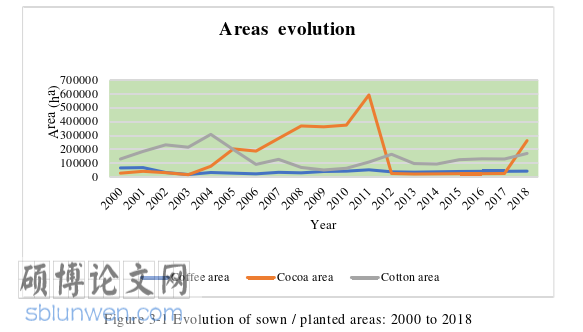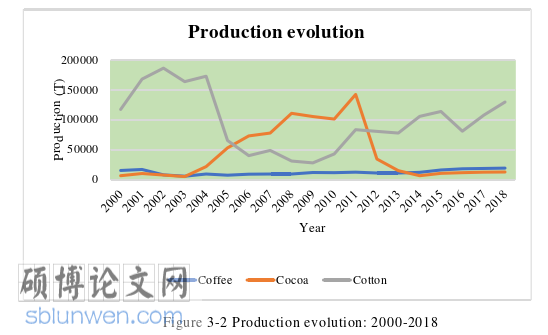1 Introduction
1.1 Research background and significance
1.1.1 Background
Togo is located in western Africa, with a population of about 7.9 million and an area of 56785 square kilometers. It borders Benin to the east, Ghana to the west, Burkina Faso to the north, and the Gulf of Guinea to the south. The south has a tropical rainforest climate, and the north has a tropical grassland climate. The average annual temperature is 27°C in the coastal areas and 30°C in the north. Agriculture, phosphate and re-export trade are the three pillar industries.
Togo is one of the least developed countries in the world announced by the United Nations, and its agricultural productivity is not high. At the same time, Togo is a traditional agricultural country, and agriculture is the backbone of the national economy, contributing 60% of the jobs and more than 40% of GDP to Togo. Togo's main food crops include cassava, ginseng potato, corn, sorghum, rice, beans, etc. The total output in 2019 was 5.8279 million tons. For many years, the Togolese government has been committed to promoting agricultural development. Since 1983, the Togolese government has implemented an economic restructuring plan, adopted a liberalized economic policy, and prioritized the development of agriculture. Since 2011, the Togolese government has implemented the National Agricultural Investment and Food Security Plan to expand agricultural production. Togo organizes the National Farmers Forum in Kara every year to improve agricultural efficiency. The government promised at the forum that it will incre ase investment in the agricultural sector, protect farmers‟ land, and create better conditions for domestic and foreign private sector investment to promote crop production, storage, processing and sales. In March 2019, Togo launched a new national development plan (2018-2022), hoping to embark on a path of comprehensive development. Among them, the second article mentions the establishment of agricultural product processing and manufacturing industrial parks, and strive to increase the added value of products and reduce the trade deficit by 2022 by local processing of more than half of the agricultural products.
..........................
1.2 Literature review in Togo and abroad research
Efficiency first refers to effective factors, which first appeared in Latin. Efficiency was first applied mainly in mechanical engineering at the end of the nineteenth century. It was expressed in a ratio, expressed as the ratio of output to input energy. Subsequently, efficiency has been widely used in various disciplines, in addition to the most applications in economics. One of the most frequently used and widely used terms in economic practice and theoretical applications is efficiency, such as: consumption efficiency, distribution efficiency, production efficiency, organizational efficiency, exchange efficiency, dynamic efficiency, static efficiency, technical efficiency, institutional efficiency, and market Efficiency etc. That is to say, because the concept of efficiency is so widely used, so far, the concept of efficiency has not been recognized by the economics community with an exact definition.
The definition of efficiency in the most authoritative economic dictionaries in the West regards resource allocation efficiency as efficiency, and defines allocation efficiency as "resource allocation efficiency indicates that the economic operation can satisfy humanity as much as possible under technical conditions and resource constraints. Needs". Pindick calls "the sum of the welfare of producers and consumers" the efficiency of resource allocation. The concept of efficiency is also embodied in Marx's theory of surplus value, and the real wealth in the book can clarify the meaning of efficiency. He believes that real wealth is to create as much value as possible with as little value as possible. In Samuelson's book "Economics", he puts "efficiency means no waste, that is, the economy operates efficiently under such conditions: in or der to increase the production of one kind of goods, one must reduce the production of another one. The production of this kind of goods can only be realized, and the economic operation on the frontier of production is efficient" is given as the definition of "economic efficiency". Pareto believes that efficiency refers to: "Changing the allocation of a resource cannot make at least one person‟s condition better, while the status of the others remains the same, that is, there is no Pareto improvement. This can be called this resource allocation. Is the best." Although the word "optimal" is used in "Pareto optimal", the meaning it expresses actually refers to efficiency, and is considered to be "Pareto efficient "This definition of efficiency is widely used by Western economics circles. In summary, efficiency mainly shows the gap between the current production status and the best production status, and mainly shows the relationship between input and output.
..........................
2 Concept definition and theoretical basis
2.1 Total factor productivity theory
2.1.1 The concept of total factor productivity
Regarding the concept of total factor productivity, it has attracted the attention of the academic community a long time ago. It really originated from the American national standa rd "Industrial Engineering Terminology", which regards total factor productivity (TEP) as the total output and all input factors. The ratio of the total amount, but in the production process, due to the difference in the statistical manifestations of input and output, the existence of this difference produces a variety of evaluation and calculation methods for total factor productivity. In the early research on total factor productivity, the American economist Soro believed that total factor productivity is equal to total productivity minus the productivity brought by the input factors of production, specifically referring to the input labor and capital factor productivity, that is, total factor productivity is productivity. The part of value-added that cannot be explained by labor and capital productivity. It is that total factor productivity is an efficiency index that reflects the transformation of production input into final output. It can measure technological changes other than labor and capital changes, and is an important indicator commonly used to measure economic growth. Solow believes that economic growth depends on capital and labor input and technological progress, and considers technological progress as an input factor independent of labor and ca pital. Ma Hanwu (1999) believes that total factor productivity is a measurement and evaluation indicator, which can measure the resource utilization efficiency of a sector or a country, as well as the overall economic development level of a sector or a country.
Many scholars also believe that since it is total factor productivity, it should include all factors of production, and should not exclude capital and labor. The more factors of production that are considered, the more comprehensive the total factor productivity calculated will be more researched. significance. The divergence in the definition of total factor productivity mainly stems from the definition of "total factors", whether it should include all production input factors including capital, labor, technology, management, and climate, or whether to exclude capital and labor production factors For the convenience of research, this article also draws on the investigation of total factor productivity by many scholars at home and abroad, and believes that total factor productivity should follow Solow's concept of total factor productivity, which is defined as in addition to the two major material factors of capital and labor. The growth rate of total output brought about by all other production input factors.
.........................
2.2 Efficiency theory
2.2.1 Efficiency
As one of the common basic concepts in economic society, efficiency has extremely rich and important connotations. It is generally believed that efficiency mainly refers to the effectiveness of the allocation of scarce resources, that is, through the different combinations of v arious elements in the allocation of different subjects, so that each input element is transformed into the output capacity. When it is at the optimal efficiency, the allocation of various resources reaches the most reasonable level. In modern economic theory, we also call it Pareto efficiency or Pareto optimal. Specifically, Pareto Optimality is based on the assumption that certain technologies and the limited scarce resources that can be allocated, the overall situation of all people is at the optimal lev el. If the benefits of some people are to be further improved, then It can only be achieved under conditions that harm the benefits of others.
2.2.2 Production efficiency
Production efficiency refers to the ratio between the observed value of output and the maximum theoretical output under a certain technological level and given input factors. At the same time, production efficiency is also a measure of the performance leve l of an economic individual under the conditions of specific input elements, costs, profit goals, and income, that is, it reflects the degree of achieving the ideal goal of maximum output. It is generally believed that input is the sum of the quantity or amount of resource elements used in production and operation, and all the benefits brought by these input resource elements in the process of production and operation are output. We can determine whether the resource allocation plan is efficient through the corresponding relationship between the input and output of resource elements in the process of production activities. When it is satisfied that the most output is obtained with the least input elements, we believe that the resource combination allocation plan is reasonable and efficient (Cui Guang 2013).

经济论文参考
....................................
3 多哥经济作物发展状况 .............................................. 26
3.1 多哥农业在世界农业发展中的地位 ............................. 26
3.2 多哥经济作物发展现状... ............................... 27
4 多哥经济作物的生产效率测度 ........................... 34
4.1 效率的定义 ...................................... 34
4.2 效率的评价方法 ....................................... 35
5 多哥经济作物生产效率影响因素的实证分析 ................................ 45
5.1 变量选取及类型 ............................... 45
5.2 实证分析 .............................................. 46
5 An empirical analysis of influencing factors in Togo‟s economic crop production
5.1 Variable selection and type
In this paper, Tobit model was used to further analyze the factors affecting the production efficiency of cash crops in Togo.The dependent variable, the togolese cash crop productivity (EFFIC), is calculated in detail in Chapter 4.Independent variables are factors that affect the production efficiency of cash crops in Togo.According to the characteristics of the economic crop production, in combination with related literature, from the impact of economic crop production of people, goods, content, natural conditions and so on selection factors, main production areas, the main choice Togo economic crop land circulation, basic education level, the financial funds for supporting agriculture, natural disasters and other factors, and make the following assumptions:
(1) Land transfer positively promotes the production efficiency of cash crops.Land transfer is conducive to large-scale production of cash crops, further forming scale effect and large-scale centralized production, which is conducive to realizing higher agricultural mechani zation level and improving production efficiency of cash crops.In this paper, a dummy variable is used to represent land transfer (LZ). The value of LZ is 1, otherwise it is 0.
(2) The lower the level of basic education, the lower the efficiency of cash crop production.The peasant household is the main body of production, and its cultural level directly affects the production efficiency.The low level of basic education in rural areas discourages farmers from using advanced technology.In this paper, the proportion of high school education and above in the population aged 15 and above (EDU) is used to indicate the level of rural basic education. (3) Financial support for agriculture has a positive effect on the production efficiency of cash cropsAdequate government investment can provide cotton farmers with the hardware facilities needed for production, and increasing government investment in cash crop production is an external condition to ensure the high efficiency of cash crop production.In this paper, the proportion of agricultural fiscal expenditure to total fiscal expenditure (FIN) is used to represent the agricultural production capital input level in each cash crop producing area.

经济论文怎么写
6 Conclusion and recommendations
6.1 Conclusion
From the perspective of the production efficiency of different cash crops, the overall production efficiency of Togolese cotton growers, cocoa growers and coffee beans growers is equivalent, all between 0.550-0.56. The difference in technical efficiency and scale efficiency of the three types of farmers is obvious. From the perspective of production efficiency in different economic regions, Region Centrale has the highest overall production efficiency, and Region Maritime has the second highest overall production efficiency. The production efficiency of Region des Savanes, Region deKara and Region des Plateaux is significantly behind, with 0.527, 0.466 and 0.398 respectively. Region Centrale has the highest technical efficiency at 0.933, indicating that the input elements of the Central Region are highly utilized. At the same time, the scale efficiency of this area is 0.731, indicating that the ratio of input factors in this area is more appropriate. Region Maritime has the highest scale efficiency at 0.817, indicating that the input elements of the coastal area are more efficient in use. The low scale efficiency of Region des Plateaux, Region Centrale, and Region des Savanes indicates that the use of input elements in these regions is inefficient, and it is necessary to improve the efficiency of input element allocation. Analyze the overall production efficiency of Togo‟s cash crops from the time dimension. From 2015 to 2019, the overall production efficiency of cash crops in the Central Region has always remained the first, and during the five-year period, the increase has been significant, from 0.451 to 0.682. During 2015-2019, the overall production efficiency of Maritime District and Kara District also showed an upward trend, and the upward trend was significant. However, from 2015 to 2019, the overall production efficiency of the Savane and plateaux areas stagnated and did not improve.
This paper further uses the Togo efficiency data and uses the DEA-Tobit model two-stage method to analyze the impact of land transfer and element input on the production efficiency of agricultural crops, enriching the research in this field, and the main conclusions obtaine d are: the average of the sample farmers The production efficiency is only 0.143, which is at a very low level, and there is still much room for improvement. The main reason for the low efficiency is the low technical efficiency, which shows that the application of agricultural production technology of the sample farmers needs to be improved urgently. Agricultural land transfer (including transfer and transfer), peasant household education level and financial support to agriculture can significantly promote the improvement of cash crop production efficiency. Finally, natural disasters are not conducive to improving the production efficiency of cash crops.
reference(omitted)
